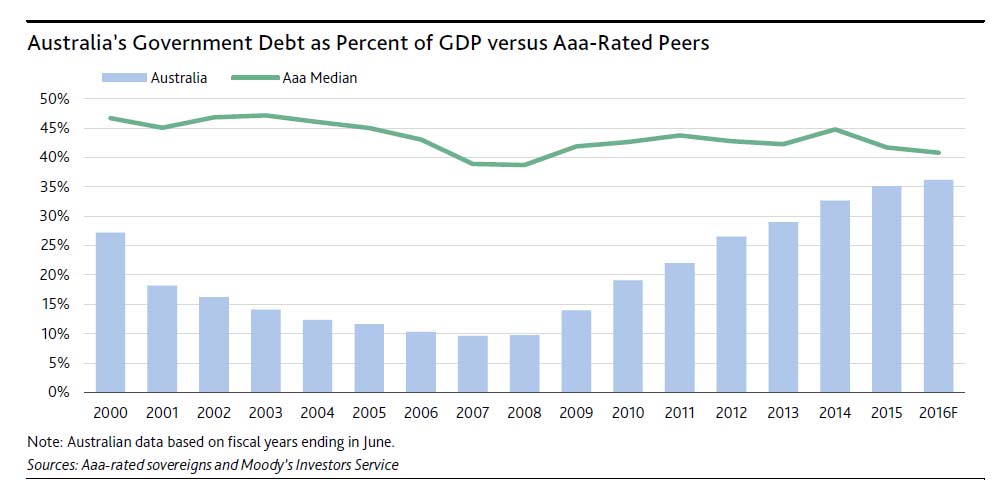Treasurer Scott Morrison announced that the budget to be released on 3 May would focus on curbing spending to lower the government’s fiscal deficit. However, given previous difficulties in reducing welfare benefits, actual spending cuts may be modest. Moreover, Mr. Morrison’s announcement excluded measures to raise revenues. Without such measures, limited spending cuts are unlikely to meaningfully advance the government’s aim of balanced finances by the fiscal year ending June 2021 and government debt will likely continue to climb, a credit negative for Australia says Moody’s.
Notwithstanding Australia’s favourable fiscal metrics relative to Aaa-rated peers, Australia has had a prolonged and marked increase in government debt over the past decade. During a period of relatively strong GDP growth, Australia’s government debt has risen to 35.1% of GDP in fiscal 2015 from 11.6% 10 years earlier. We expect government debt to increase further to around 38% of GDP in fiscal 2018.
 The 3 May budget will provide more detail on measures aimed at limiting expenditure growth. However, the government’s pledge to curb spending will be tested by significant spending commitments on welfare, education and health. Despite a consensus on fiscal consolidation through successive administrations, the government has been unable to reduce expenditures to significantly below 36.5% of GDP since 2009.
The 3 May budget will provide more detail on measures aimed at limiting expenditure growth. However, the government’s pledge to curb spending will be tested by significant spending commitments on welfare, education and health. Despite a consensus on fiscal consolidation through successive administrations, the government has been unable to reduce expenditures to significantly below 36.5% of GDP since 2009.
Moreover, fading prospects for tax reform present challenges to boosting government revenues at a time when lower commodity prices are weighing on receipts from corporate profits and income taxes. Changes to superannuation tax concessions are still on the agenda and will raise government revenues, but they will be insufficient in achieving a balanced budget within five years.
Meanwhile, an increase in the goods and services tax to 15% from 10% that was envisaged earlier and would have raised an estimated AUD35 billion, according to the treasury, has been shelved. Other tax changes that would result in savings to the government are proving difficult to adopt ahead of an election later this year. Measures to streamline tax returns, which would reduce tax administration costs to the government, are now also unlikely to be part of the budget.
Plans to alter negative gearing policies and capital gains taxes, which support residential investment and house prices, but weigh on government finances, are proving divisive. The opposition Labor party argues that limiting negative gearing to purchases of new homes and reducing the capital gains tax discount on asset sales to 25% from 50% would improve the budget position by AUD32.1 billion over the 10-year period starting July 2017. The governing coalition has rejected a narrowing of the scope of negative gearing policies on the grounds that it would have a significant negative effect on the housing market.
